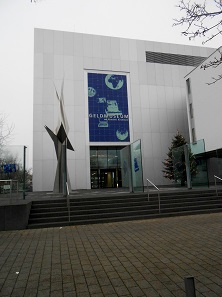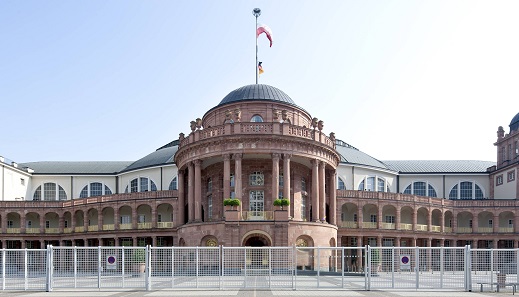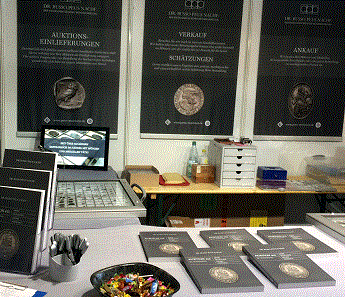by Frank Berger
translated by Annika Backe
Frankfurt is the city of banks and commerce. But Frankfurt is also a city of numismatics. Probably no one knows this better than Frank Berger. He shows us what numismatists and coin collectors should know about the metropolis on the Main River and which addresses should ring a bell.
Model of the Historisches Museum Frankfurt from 2009.
Historisches Museum Frankfurt
Opened in 1878, the Historisches Museum Frankfurt (Historical Museum Frankfurt) has one of Europe’s largest collections of coins, medals and banknotes. It harks back to a donation made in 1749. The many sections of coins on display alone are worth a visit.
Nearly 5000 ancient coins, gems, medals, the states of the Holy Roman Empire of the German Nation from 794-1806, up until the mark currency and its end can be viewed. Following a complete renovation in 2012 and the construction of a new museum building from 2011-2017, numerous new exhibition sections that are related to numismatics were opened in October 2017.
Read more about the collection’s history and the description of a detailed tour in this article in German.
Historisches Museum Frankfurt (Historical Museum Frankfurt)
Saalhof 1
60311 Frankfurt
Phone 069-21234499
www.historisches-museum-frankfurt.de/en
Tue-Fr 10am-6pm, Wed 10am-9pm, Sat+Sun 11am-7pm, closed on Mondays
Entrance 8 euros, reduced 4 euros
Contact for visiting professionals: Dr. Frank Berger
The building of the Money Museum of the Deutsche Bundesbank.
The new (!) Bundesbank Money Museum
The Money Museum of the Deutsche Bundesbank was opened in 1999. From the very beginning, this institution has been very popular with the public. An average of 40,000 visitors per year found their way into the beautiful exhibition building located on the “Diebsgrund” plot in Frankfurt-Ginnheim. Admission to the Bundesbank Money Museum was and still is free.
The exhibition area used to be 600 square meters. In September 2014 this exhibition was closed and dismantled. After an annex has been added to the ground floor, the exhibition space now amounts to 1000 square meters. The costs involved were 19 million euros. What the colleagues – in the fields of numismatics, these are Reinhold Walburg, Ulrich Rosseaux, and Alexander Ruske – have achieved, in terms of its substance, in a relatively short period of time is simply magnificent. The Bundesbank’s new Money Museum has little in common with the “old” Money Museum from 1999 anymore. There has been no rebuilding but rather a new building, also from an architectural point of view, as well as a complete revision of the concept.
Read in detail about the Money Museum and the new exhibition here in this article in German.
((Link News 3de))
Geldmuseum der Deutschen Bundesbank (Money Museum of the Deutsche Bundesbank)
Wilhelm-Epstein-Straße 14
60431 Frankfurt
Phone +49 69-9566-3073
www.bundesbank.de
Mon-Fri 9am-5pm, Wed 9am-8pm, Sun 9am-5pm, closed on Saturdays
Entrance is free
Contact for visiting professionals: Dr. Ulrich Rosseaux, Dr. Alexander Ruske, Dr. Hendrik Mäkeler
The corporate logo of Degussa-Goldhandel.
The Degussa Gold Museum
Degussa was founded in 1873 as “Deutsche Gold- und Silber-Scheideanstalt vormals Roessler AG” (German Gold and Silver Refinery formerly Roessler) in Frankfurt am Main. It emerged from the Frankfurter Scheideanstalt, which had begun operation 30 years earlier. The Frankfurt-based assayer Friedrich Ernst Roessler (1813-1883) had leased it first and then ran it as a private company. The foundation of the joint-stock company was directly caused by the introduction of the mark after the foundation of the German Empire in 1871. The coins of six different currencies had to be melted down in order to gain the material needed for the production of the new gold and silver coins. Soon the field of activities expanded to include further products made from precious metal as well as chemicals. In 1965 the Degussa Group generated DM 1.446 billion and had 12,400 employees, which increased to DM 13.9 billion and 35,000 employees in 1990. Degussa was integrated into the Evonik Industries AG in 2007.
Kettenhofweg 19, future location of the Degussa Gold Museum.
In 2010 the August von Finck junior consortium acquired the rights to use the venerable Degussa brand name for roughly 2 million euros.
Gold bars from the Degussa gold collection.
Under the name “Degussa Sonne / Mond Goldhandel GmbH”, a precious metal trading house was founded in Munich, headquartered in Frankfurt am Main.
Gold bars from the Degussa gold collection.
With around 130 employees, the turnover amounted to around 1.9 billion euros (2016).
Degussa employee from the gold sales department.
“Degussa Goldhandel” has been building the Degussa Gold Museum in the Kettenhofweg in Frankfurt’s Westend district, five minutes from the Alte Oper (Old Opera), since 2015. The opening is scheduled for 2018.
Goldmuseum der Degussa (Degussa Gold Museum)
Kettenhofweg 19
60325 Frankfurt
(Data in preparation)
Contact for visiting professionals: Dr. Nadja Tomoum
“101 Geldorte in Frankfurt”
This is the title of a book authored by Frank Berger, published in 2016 and available for 12.80 euros in bookshops. As the title already suggests, it focuses on places in the Frankfurt cityscape that have a connection to numismatics and monetary history and which are certainly worth a visit.
The excavations of the Carolingian Palatinate on the Cathedral Hill, where Frankfurt’s first mint used to be.
Mentioned are several places where the mints of the city used to be. In the Höllgasse, bracteates and at the Brückhof the gold gulden featuring the imperial orb were struck; in Hoechst, the Archbishop of Mainz minted his gold gulden; in the Barfüsserkloster the first Frankfurt taler was minted; and in the Münzgasse the minting of Frankfurt coinage ended in 1879.
The house called “Zum Wechsel” at the Römer, residence of a mintmaster in the 15th century and a currency exchange office up until the present day.
Banknotes for the Kingdom of Japan and the German Empire were printed at Dondorf & Naumann located at the Kleiner Kornmarkt.
Rödelheim Castle, where the coins of Solms-Rödelheim were minted.
At the Alte Brücke a gold treasure was found that had been buried around 1400, and in Preungesheim a treasure trove from the 30 Years’ War was discovered. Counterfeiting was done in the Allerheiligengasse. We know the names of Frankfurt-based banking families: Rothschild, Bethmann, Metzler, Hauch, Erlanger, Grunelius, Sulzbach, Gontard, Goll, Goldschmidt, Speyer, Dreyfus, Andreae, Willemer, Schönemann, and many more.
The Frankfurt Stock Exchange had several locations. Founded in 1585 at the Römer, it was later situated at the Liebfrauenberg, then in the Neue Kräme, then on the Börsenplatz, then in Hausen; today it is located in Eschborn.
The building of the European Central Bank in Frankfurt’s Ostend.
As the state bank of the Free City, the Frankfurter Bank was last based in Bockenheimer Landstrasse, home also to the Bank Deutscher Länder, the Bundesbank and the European Central Bank.
The building of Merck, Finck & Co. in the Lindenstraße, headquarters of the Kreditanstalt für Wiederaufbau (Reconstruction Credit Institute).
The many major banks include the skyscrapers of the following: Deutsche Bank, Dresdner Bank, Commerzbank, DZ-Bank, and UBS. The Volksbank and the Sparkasse should not go unmentioned, either.
The “Pfennigdenkmal” (Pfennig Monument) by Vollrad Kutscher in the Taunusanlage, inaugurated in 2001.
A very special object is the “Pfennigdenkmal” (Pfennig Monument) by Vollrad Kutscher in the Taunusanlage, in whose shade the two Deutsche Bank towers are located.
After the visitor with an interest in numismatics and monetary history has seen enough coins and has been told adequately about finance, he can use this little book to take inspiring walks through the city center of Frankfurt.
Frank Berger, 101 Geldorte in Frankfurt, Frankfurt 2016, 216 pages, 12.80 euros.
A detailed review of the book can also be found on our German page MuenzenWoche.
Collectors and dealers
Frankfurter Numismatische Gesellschaft
The most important association of collectors is the Frankfurter Numismatische Gesellschaft (Frankfurt Numismatic Society) of 1906. As laid down in its statutes, its aim is the care of numismatics in Frankfurt. Every third Wednesday of the month (except July and August) at 6pm a lecture is held at the Historisches Museum Frankfurt, the headquarters of the society. Guests are welcome to attend the lectures, with free admission. Topics addressed include the fields of coins, medals as well as paper money. For an annual fee of currently 42 euros, you will get the monthly issue of the magazine “Numismatisches Nachrichtenblatt”. The society is in close contact with the Historisches Museum Frankfurt and the Frankfurt coin trade.
Frankfurter Numismatische Gesellschaft
Dr. Frank Berger
P.O. box 900553
60445 Frankfurt
Phone +49 69-21234499
E-Mail
www.frankfurter-numismatische-gesellschaft.de
The logo of the Gesellschaft für Internationale Geldgeschichte (GIG) (Society for the International History of Money).
Gesellschaft für Internationale Geldgeschichte
The same applies to the “Gesellschaft für Internationale Geldgeschichte” (Society for the International History of Money). Also based in Frankfurt, the GIG publishes six volumes of its magazine “Geldgeschichtliche Nachrichten” every year. The annual fee is currently 50 euros. An annual general meeting is held at the Historisches Museum Frankfurt.
Gesellschaft für Internationale Geldgeschichte
c/o Monika Kotzek
Oskar Zimper Str. 6
64732 Bad König
Phone +49 6063-5778936
E-Mail
www.gig-geldgeschichte.de
Numismata: the “Festhalle”, venue of the NUMISMATA Frankfurt, held annually in November.
Numismata Frankfurt
Once a year a large international coin fair, the “Numismata Frankfurt” takes place in Frankfurt. At the beginning of November we see numerous visitors at the Numismata, above all, of course, coin collectors, distinguished companies, auction houses and mints from a great number of countries. Then, Frankfurt becomes the Mecca of German numismatics for two days.
Numismata Frankfurt
Erich Modes
Reichenbachstr. 17
80469 Munich
Phone +49 89-26 83 59
E-Mail
www.numismata.de
Bornwiesenweg 34, where the numismatic dealership Peus is headquartered.
Dr. Busso Peus Nachf.
Founded in 1870, the Frankfurt-based company Dr. Busso Peus Nachf. is the oldest numismatic dealership in Germany. Several times a year, the company conducts auctions at which the full range of numismatics, from antiquity to the present day, is offered to an international audience.
Fair booth of the Peus company.
The company maintains a large stock, from which collectors can also buy outside the auctions.
Dr. Busso Peus Nachf.
Christoph Raab
Bornwiesenweg 34
60322 Frankfurt
Phone +49 69-9596620
E-Mail
www.peus-muenzen.de
Mon-Fri 10am-12am and 2pm-5pm
Further numismatic dealerships
(Visits by appointment)
Rüdiger Kaiser
Mittelweg 54
60318 Frankfurt
Phone +49 69-5971109
E-Mail
Zlatko Plesa
Reichsburgstr. 4
60489 Frankfurt
Phone +49 69-26090656
E-Mail
William P. Houston
Böcklinstr. 2
60596 Frankfurt
Phone +49 69-637742
E-Mail
Münzen Medaillen Frankfurt
Rossmarkt 10
60311 Frankfurt
Phone +49 69-26090656
E-Mail
www.mm-frankfurt.de
Briefmarken und Münzen Gittel
Berliner Str. 32
60311 Frankfurt
Phone +49 69-772997
E-Mail
Massoud Hadjigoli
Bornwiesenweg 12
60322 Frankfurt
Phone +49 69-555463
E-Mail
Herbert Spreitzer
Reifenberger Str. 57
60489 Frankfurt
Phone +49 69-784133
Therese Weiser Nachf.
Battonnstr. 23
60311 Frankfurt
Phone +49 69-675148
E-Mail
www.auktionshaus-weiser.de




















